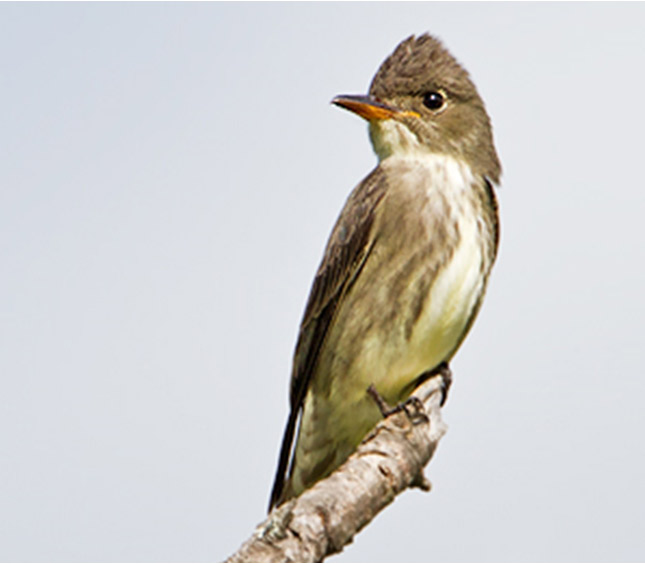“Quick, free beer!”
If you’ve heard this distinctive rapid call in the boreal forests of Alberta, it’s probably not coming from the local pub, but from an olive-sided flycatcher.
Olive-sided flycatchers are stout songbirds found across Canada in forest clearings surrounding rivers, bogs, and marshes where insect populations are high. They are named for their grey-olive colouring which provides excellent camouflage in their wooded range making them difficult for birders to spot save for their unique song, “quick, free beer!” Olive-sided flycatchers are territorially aggressive and have been known to knock squirrels and other birds out of trees to protect their nest (Olive-Sided Flycatcher). They also have one of the longest recorded ranges of flycatchers with some migrating between Alaska and Bolivia annually (Contopus Cooperi).
While this species does well in post-fire areas, having a preference for catching prey on the wing from high tree snag perches, other tree-clearing activities seem to have detrimental impacts on their numbers. The olive-sided flycatcher population has been declining steadily for several decades. Although little is known about the direct cause of the decrease, contributing factors likely include a decrease in insects, fire suppression, logging, mining, and conversion of land for commercial and residential uses. Unfortunately, the breeding and feeding habits of the olive-sided flycatcher make them less resilient to additional threats. A lengthy nesting period increases the risk of predation while a dependence on insects can make for a tenuous food supply during inclement weather (Recovery Strategy for the Olive-Sided Flycatcher).
In an effort to protect this species, federal, provincial, and territorial partners have come together to develop the Recovery Strategy for the Olive-Sided Flycatcher and the proposed Multispecies Action Plan for Jasper National Park of Canada. Although there are some concerns about the effectiveness of these measures, these strategies should increase population reporting to provide better data on this songbird’s ideal habitat while clarifying the most pressing threats to the species so that improved plans for recovery can be created in future.
Approximately one-quarter to one-third of AIWC patients each year are songbirds. To help us rehabilitate and release these wild lives, sponsor a songbird on our website.
By Stephanie Ruddock, AIWC Volunteer
Photo Credit: Government of Canada Species at Risk Public Registry
Sources:
“Olive-Sided Flycatcher.” Environment Canada Species at Risk. Web. 01 Aug. 2017. <https://www.speciesatrisk.ca/SARGuide/download/Olive-Sided%20Flycatcher.pdf>.
“Contopus Cooperi”. Boreal Songbird Initiative. Web. 15 Nov. 2015. Web. 01 Aug. 2017. <https://www.borealbirds.org/bird/olive-sided-flycatcher>.
“Recovery Strategy for the Olive-sided Flycatcher.” (n.d.): n. pag. Environment Canada Species at Risk. Web. 01 Aug. 2017. < https://www.registrelep-sararegistry.gc.ca/virtual_sara/files/plans/rs_olive-sided%20flycatcher_e_final.pdf>







2 thoughts on “Meet the Olive-Sided Flycatcher!”
I have one of these birds making a nest in my overhang 50 km west of Edmonton. So far so good, two flight-ready baby birds are still hanging around with mom and pop. Never seen this bird before and happy it chose a place for its best with us! Seems very protective and gives me a good earful every time I go outside and walk by the best site.
That’s awesome, thank you for sharing! 🙂